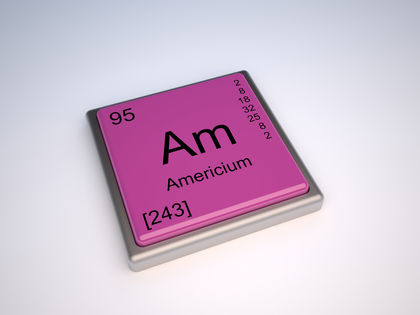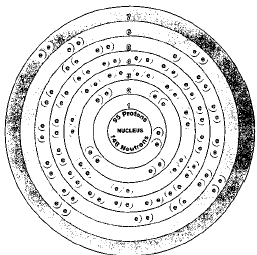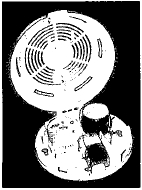AMERICIUM


Overview
Americium is called an actinide or transuranium element. It occurs in Row 7 of the periodic table, a chart that shows how the chemical elements are related to each other. The first element in that row is actinium, which explains the name actinide. The term transuranium means "beyond uranium" on the periodic table. Uranium has an atomic number of 92. Any element with an atomic number larger than 92, therefore, is called a transuranium element.
Discovery and naming
Americium was discovered as a by-product of military research during World War I I (1939-45). The U.S. government maintained a major research site at the University of Chicago during the war. Work there led to the development of the first atomic bomb. During that research, a team from the University of California, consisting of Glenn Seaborg (1912- ), Albert Ghiorso (1919- ), Ralph A. James, and Leon O. Morgan (1919- ), discovered a new element, which would eventually be named americium.
SYMBOL
Am
ATOMIC NUMBER
95
ATOMIC MASS
243.0614
FAMILY
Actinide
Transuranium element
PRONUNCIATION
am-uh-REE-see-um
Americium was first produced in a nuclear reactor. A nuclear reactor is a device in which elements are bombarded by neutrons, sometimes forming new elements. The name, americium, in honor of the American continent, was chosen because the new element occurs just below europium (named for Europe) in the periodic table.
Physical properties
Enough americium has been produced to determine a few of its properties. It is a silvery-white metal with a melting point of about 1,175°C (2,150°F) and a density of about 13.6 grams per cubic centimeter. A number of its compounds have been produced and studied, but only one isotope has considerable practical use outside the laboratory.
Occurrence in nature
All of the transuranium elements, including americium, are synthetically produced. None exist in nature.
Isotopes
All isotopes of americium are radioactive. The most stable is americium-241. Isotopes are two or more forms of an element. Isotopes differ from each other according to their mass number. The number written to the right of the element's name is the mass number. The mass number represents the number of protons plus neutrons in the nucleus of an atom of the element. The number of protons determines the element, but the number of neutrons in the atom of any one element can vary. Each variation is an isotope. A radioactive isotope is one that breaks apart and gives off some form of radiation.
The half life of a radioactive element is the time it takes for half of a sample of the element to break down. The half life of americium-241 is 432.7 years. For example, suppose a laboratory made 10 grams of americium-241. At the end of 432.7 years (one half life), only half would remain. The other half would have changed into a new element.
Extraction
Americium does not occur naturally.
Uses
Americium-241 is the only isotope of americium of any practical interest. When it decays, it gives off both alpha rays and gamma rays. Alpha rays do not travel very far in air, but gamma rays are very penetrating, much like X rays. The gamma rays from americium-241 are used in portable X-ray machines that can, for example, be taken into oil fields to help determine where new wells should be dug.
Americium-241 is also used to measure the thickness of materials. For instance, a small piece of americium-241 can be placed above a conveyor belt carrying newly made glass. A Geiger counter, a device for counting alpha radiation, is placed below the conveyor belt. If the glass is always the same thickness, the same amount of alpha radiation gets through to the detector. If the glass is thicker than normal, less alpha radiation gets through. If the glass is thinner than normal, more radiation gets through. The detector will register if the glass being produced is too thick or too thin.
The most common use of americium-241 is in certain kinds of smoke detectors. (See accompanying sidebar for more information.)
Where's there's smoke, there should be americium there

O ne of the simplest and cheapest safety devices found in homes and other buildings is a battery-operated smoke detector. And americium is an important part of it. A small piece of americium oxide made with the americium-241 isotope is sealed inside the smoke detector. The americium-241 gives off alpha particles. The alpha particles strike air molecules, causing them to break apart. The pieces formed in this process—ions—are electrically charged.
The electrically charged ions help carry a current from one side of the detector to the other. The current continues to flow as long as nothing other than air is inside the detector. If smoke enters the detector, the smoke particles absorb some of the alpha particles so that the current is interrupted. When this happens, a buzzer or other sound is set off.
Safety experts recommend changing smoke detector batteries on the same days that Daylight Savings Time begins (in the spring) and ends (in the fall). "Spring forward, fall back, and change your smoke detector battery!"
If swallowed, americium is deposited in the bones where the radiation it gives off kills or damages cells, causing cancer.
Compounds
There are no known commercial uses of americium compounds.
Health effects
Americium is an extremely toxic element. If swallowed, it is deposited in the bones. There, the radiation it gives off kills or damages cells, causing cancer. People are normally in no danger from smoke detectors containing americium-241. (Indeed, countless lives a year are saved in the United States because of smoke detectors.) The amount of this isotope in a smoke detector is very small. One gram of americium oxide made with americium-241 will make 5,000 smoke detectors.